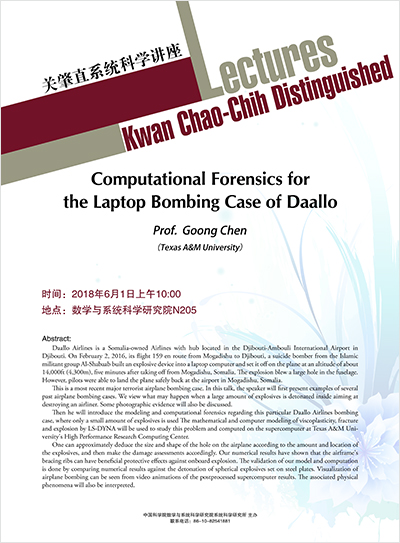主讲人:Prof. Goong Chen(Texas A&M University)
时间:2018年6月1日上午10:00 地点:N205

【Abstract】 Daallo Airlines is a Somalia-owned Airlines with hub located in the Djibouti-Ambouli International Airport in Djibouti. On February 2, 2016, its flight 159 en route from Mogadishu to Djibouti, a suicide bomber from the Islamic militant group Al-Shabaab built an explosive device into a laptop computer and set it off on the plane at an altitude of about 14,000ft (4,300m), five minutes after taking off from Mogadishu, Somalia. The explosion blew a large hole in the fuselage. However, pilots were able to land the plane safely back at the airport in Mogadishu, Somalia.
This is a most recent major terrorist airplane bombing case. In this talk, the speaker will first present examples of several past airplane bombing cases. We view what may happen when a large amount of explosives is detonated inside aiming at destroying an airliner. Some photographic evidence will also be discussed.
Then he will introduce the modeling and computational forensics regarding this particular Daallo Airlines bombing case, where only a small amount of explosives is used The mathematical and computer modeling of viscoplasticity, fracture and explosion by LS-DYNA will be used to study this problem and computed on the supercomputer at Texas A&M University's High Performance Research Computing Center.
One can approximately deduce the size and shape of the hole on the airplane according to the amount and location of the explosives, and then make the damage assessments accordingly. Our numerical results have shown that the airframe's bracing ribs can have beneficial protective effects against onboard explosion. The validation of our model and computation is done by comparing numerical results against the detonation of spherical explosives set on steel plates. Visualization of airplane bombing can be seen from video animations of the postprocessed supercomputer results. The associated physical phenomena will also be interpreted.